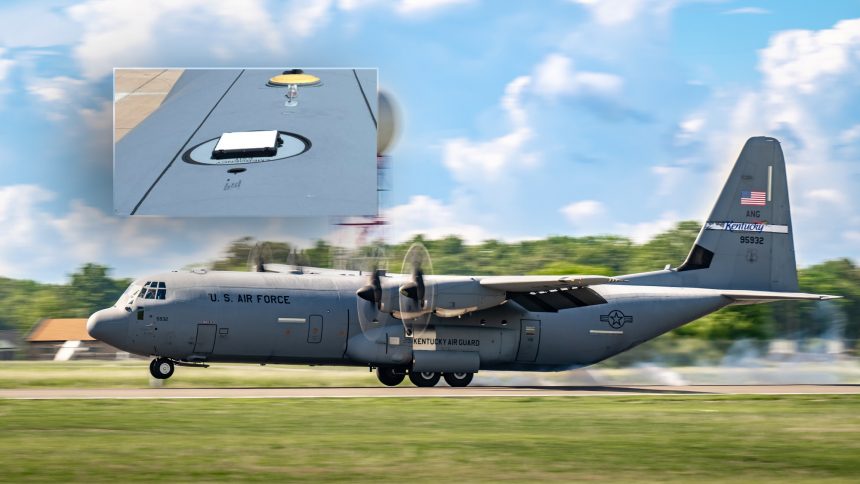The service is looking for an alternate rapid tactical communications and data-linking capability to better equip the mobility fleet for logistics in high-end, contested environments.
The 317th Airlift Wing at Dyess AFB, Texas, is working towards the Air Mobility Command’s (AMC) vision to have 25% of its fleet with alternative Line-of-Sight (LOS) and Beyond Line-of-Sight (BLOS) satellite broadband internet-based tactical communications and data link systems. Under the ‘25 by 25’ initiative by former AMC commander Gen. Mike Minihan, the 317th AW tested on Jun. 4, 2025, the “advanced communications hardware for certification on a C-130J Super Hercules,” by installing a transceiver of SpaceX’s military-specific Starshield on the escape hatch.
The upgrade, which features the “latest carry-on, carry-off airborne tactical communications system,” has the goal of “enhancing situational awareness and command connectivity for future missions,” explained the press release. The system is known as the “Joint Deployable Airborne Package” and, paired with “hatch-mounted radio frequency antennas,” enables “commercial satellite communications through SpaceX’s Starshield Low Earth Orbit constellation, providing ultra-high-frequency, secure, beyond-line-of-sight capabilities.”
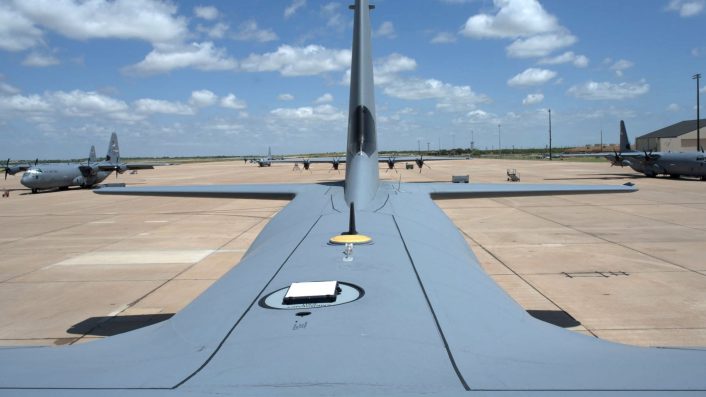
The advantage of the “mini hatch-mount” is that it does not require any modification to the airframe and can be handled by non-specialized maintenance personnel. “These enhancements support up to four independent tactical networks at varying classification levels through integrated network and server modules,” the release added. The U.S and its allies currently use the Link 16 tactical data link across their platforms, and a newer Link 22 is also being operationalized.
Rapid, modular, easy tactical communications
The images released on the DVIDS network showed a square-shaped antenna on an existing hatch that was raised from inside the cargo hold of the C-130J. Personnel from the U.S. Army’s 4th Joint Communications Support Element and the USAF’s 317th Aircraft Maintenance Squadron conducted “operational checks” by executing “test cards”; a “high frequency radio”; scanning “frequency interference with a spectrum analyzer,” according to the captions.
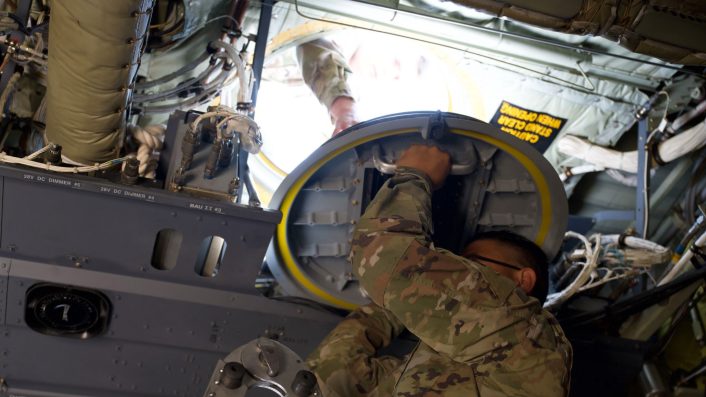
The release quoted Joint Communications Support Element portfolio manager Darrell Wheat, who said the goal is to offer joint force commanders “real-time, accurate information while in transit, enabling informed decisions.”
“Previously limited by size and cost, these capabilities now offer greater flexibility to support more users,” added Wheat. The terminals can “seamlessly” integrate with “existing aircraft systems,” allowing “quick installation and straightforward maintenance by standard maintenance crews.”
“These plug-and-play upgrades are designed for rapid setup before a mission and can be removed within minutes,” said 317th Operations Support Squadron manager Clay Holt. Holt stressed on elimination of the need for “permanent modifications” on the aircraft and “specialized training” for the crews, which are important advantages.
The system enhances “secure, in-flight connectivity for C-130J operations”; boosts “situational awareness and command connectivity”; and “supports agile operations aligned with adaptive basing and resilient communications.” This also reflects the use of the new system in Agile Combat Employment (ACE) operations that are defining the service’s effort in both the European and Pacific theaters, where the C-130 would remain the workhorse of its tactical logistics sorties.
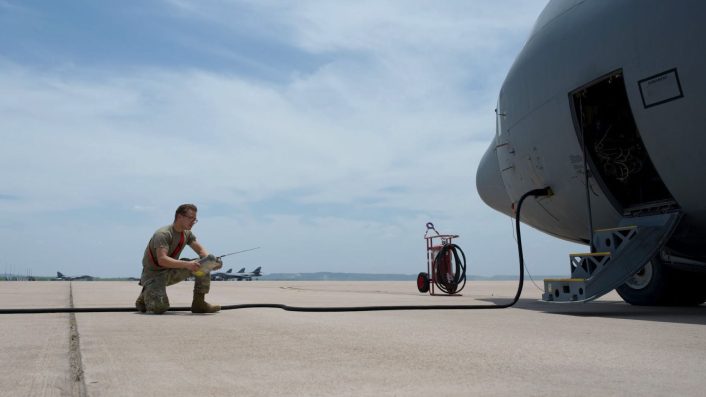
AMC’s ‘25 by 25’
The AMC’s ‘25 in 25’ initiative “aims to equip 25 percent of AMC’s fleet with in-flight communications for both secret and unclassified information by the end of 2025,” explained the service. Maj. Ryan Robinson, AMC A346 tactical data link subject matter expert, said “this supports the broader strategy of adaptive basing, resilient communications and distributed operations.”
A Jul. 2024 Air Space and Forces report about Minihan’s revelation to the House Armed Services Committee that the ‘25 by 25’ initiative “regrettably, is not possible” by FY 2025, laid out its use cases: “The connectivity […] would include fast download speeds and detailed data such as the security situation at the destination, potential air-to-air and surface-to-air threats, availability of fuel at the destination, the ability to rapidly divert, and the ability to see where safer landing places, with necessary support, are available, under combat conditions.”
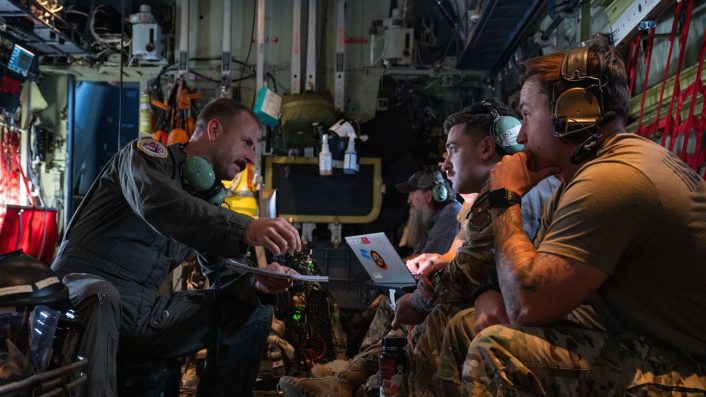
This was followed by the AMC testing a “Battle Management Maneuver System” during Exercise Bamboo Eagle 24-3 in early Aug. 2024 over the Eastern Pacific Ocean and across the Western United States. This drill saw KC-46 aircrew experimenting with Executive Communication Kits (ECKs), “allowing crew members to turn a satellite communication (SATCOM) connection into NIPR and SIPR connections.”
“Additionally, through an external antenna, crew members tested voice over secret internet protocol (VOSIP) communications access,” added the release. Aircrew also tested an “experimental Beyond-Line-of-Sight (BLOS) and Line-of-Sight (LOS) tactical data link integration hatch” on a C-130.
A @usairforce C-130J Super Hercules flies over @JBPHH, Hawaii, in support of an Agile Combat Employment, joint force integration exercise in the @INDOPACOM region. #TogetherWeDeliver @PACAF @LRAFB @AirMobilityCmd pic.twitter.com/ISpbnxa0sj
— USTRANSCOM (@US_TRANSCOM) April 15, 2021
Col. Jeremy ‘Grimm’ Gould, Future Operations and Sensitive Activities division chief at Air Mobility Command called it a “successful use of several non-standard communications.” The “self-contained Roll On/Roll Off Hatch terminal” installed aboard the C-130 escape hatch “provided high-throughput connectivity with an automated primary, alternate, contingency, and emergency communication plan.”
SpaceX and U.S. military
SpaceX has launched nearly 4,000 LEO-based Starlink satellites since 2019. Starshield meanwhile has launched nearly a dozen prototype satellites since 2020 from SpaceX’s Falcon 9 rockets, Reuters reported in Mar. 2024 quoting unidentified sources. This “helped position” SpaceX for a roughly $200 million contract, before a bigger $1.2 billion by the National Reconnaissance Office (NRO).
Having a large constellation of hundreds of LEO-positioned satellites in a “proliferated” architecture is also in line with the U.S. Space Force’s PWSA (Proliferated Warfighter Space Architecture). The project’s Transport Layer and Tracking Layer provide a resilient, low-latency communications relay network, and detect and track missiles, respectively. General Atomics also conducted in Jan. 2025 a series of trials of a Gray Eagle Extended Range drone remotely controlled through a Proliferated Low Earth Orbit satellite constellation.
Incoming! ✈️
A @374AirliftWing C-130J Super Hercules lands during Cope North 21. This exercise trained Airmen on humanitarian aid and disaster relief efforts to prepare for and recover from the devastating effects of natural disasters. @PACAF
📸 by SSgt Ryan Brooks pic.twitter.com/ByBrMfSZNd
— U.S. Air Force (@usairforce) February 18, 2021
However, the USAF availing SpaceX’s services is not new. Stars and Stripes reported in Mar. 2023 about the 730th Air Mobility Wing showing off one of its three new terminals of the civilian-use Starlink at Yokota Air Base in Japan during the visit of the Air Force Expeditionary Center commander Maj. Gen. John Klein. “A Starlink terminal set up inside a C-130J Super Hercules airlifter at Yokota allowed Klein to video conference with an airman who was using a Starlink terminal on Diego Garcia, an island more than 5,000 miles away,” the report said.
U.S. Navy and Starlink
Starlink was also used extensively in the first year of the Ukraine-Russia war, until Musk complained about its vulnerability to Russian electronic and cyber attacks. Starshield meanwhile has been used by the U.S. Marine Corps and installed aboard U.S. Navy warships too.
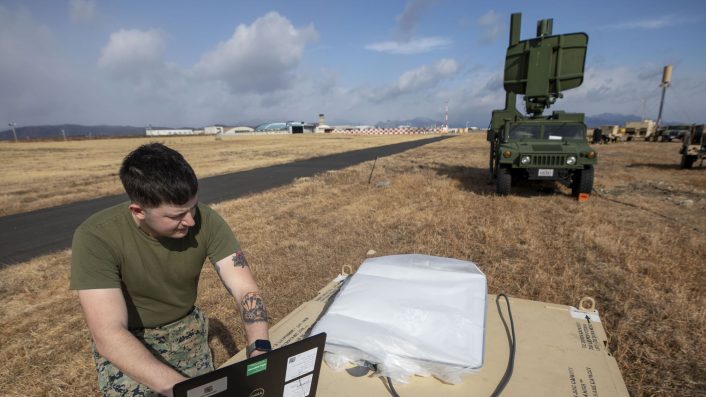
Another use case manifested with the U.S. Navy’s Air Test and Evaluation Squadron 30 (VX 30) “Bloodhounds”, based at NAS Point Mugu in California, installing a Starlink on one of its two KC-130Ts in Sep. 2024. Naval Air Systems Command (NAVAIR) confirmed to The War Zone that the KC-130T was “modified with Starlink equipment to relay communications and data beyond-line-of-sight, providing mobile range infrastructure for operations on the Point Mugu Sea Range.”
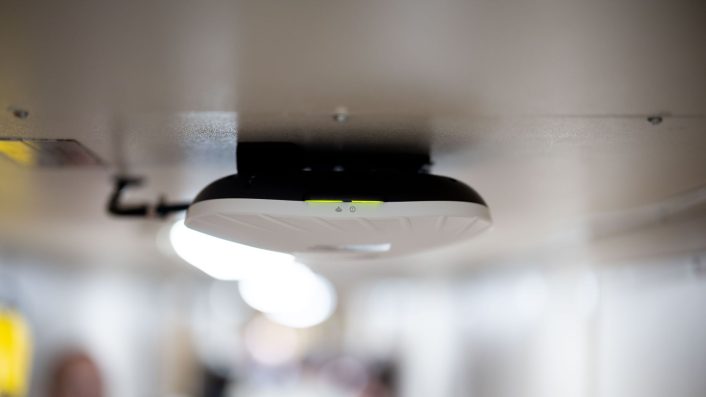
The range is used to trial several missiles and hypersonic missiles over the Pacific Ocean off the U.S.’s western seaboard. Multiple air and sea assets spread out over the tested weapon’s intended route, interconnected with high-speed satellite internet network, helps real-time relaying of data back to the test facilities.

